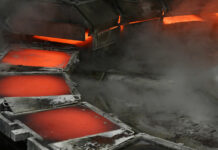
[miningmx.com] — COPPER mining company Palabora Mining, which operates South Africa’s largest copper mine, on Tuesday reported a 24% fall in first half copper concentrate production.
Releasing its first half and second quarter operations overview and production
statistics, the company said it produced 119 700 tonnes in the first half of 2010
compared to 143 200 tonnes in the corresponding period of 2009.
Copper concentrate production was six percent lower quarter-on-quarter at 57 900
tonnes in the second quarter, against 61,800 tonnes in the first quarter.
The lower production was attributed mainly to a combination of a 44% increase in
concentrate inventory of copper thickeners and a 90% drop in toll milling concentrate.
Increased inventory resulted from the processing of a higher tonnage of slag and an increase in the fineness of the feed to the filter plant which reduced the throughput of the rotary drier due to high feed moisture while the drop in toll milling concentrate was caused by the changeover to toll milling of non-copper bearing ore.
Daily production from the underground mine averaged 30,196 tonnes for the quarter to end June 2010, which is 3% lower than the previous quarter and 9% lower than the corresponding period in 2009.
This was mainly due to winder repairs and low availability of long haul dumps.
“Preventative maintenance is ongoing and winder drum replacement is scheduled for early 2011,” the company said.
In total, 2.7 million tonnes of ore were hoisted during the quarter with a copper grade of 0.64% while 5.6 million tonnes of ore was hoisted in the first half with a copper grade of 0.65%.
Average concentrate grade was 4% higher in the second than the previous quarter and the corresponding period in 2009 due to higher proportion of high grade slag reprocessed and discontinuance of toll milling of marginal ore, which was yielding lower concentrate grade.
Ore treated was 3% higher than the previous quarter and 3% lower than the corresponding period in 2009, having also been affected by lower underground production due to the winder repairs and the long haul dumps availability.
Copper in concentrate at 18 000 tonnes for the second quarter was 2% lower than the previous quarter and at 36 400 tonnes, 21% lower than the corresponding period in 2009.
New concentrate smelted was 3% higher sequentially and 12% lower than the corresponding period in 2009. This was mainly due to maintenance and replacement of the Wolff cranes and rebuild of the reverb bath.
New anode production was 19% higher sequentially and 22% lower than the
corresponding period in 2009 with the year-on-year variance due to low feed rates at the reverbratory furnace as a result of downtime at the furnace bath and maintenance and replacement of the Wolff cranes.
Magnetite production was 4% higher sequentially and 27% higher than the corresponding period in 2009, as a result of increased stockpile reclaims.
“The Transnet rail strike impacted shipments of magnetite reducing sales by 120 000 tonnes in June 2010,” the company said.
Vermiculite production was 15% lower sequentially due to furnace related production challenges.










